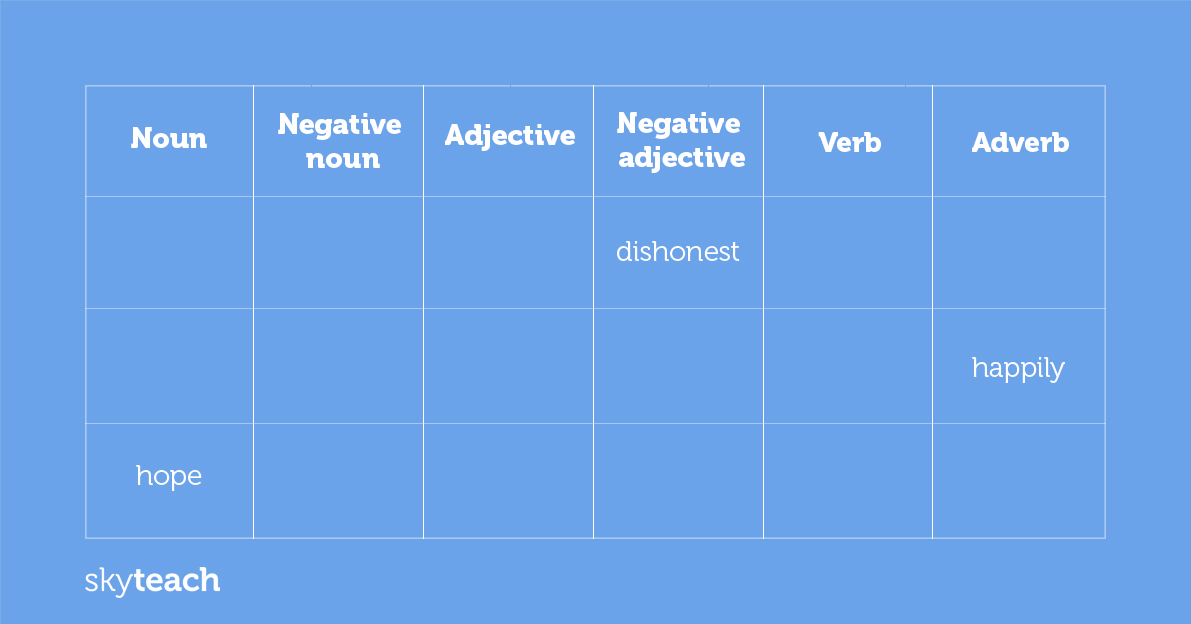‘How come a teacher teaches, but a doctor doesn’t doct? Why can’t I say ‘My aunt is a cooker’?! What do you mean ‘increase is a noun?’… Word formation has never been easy for students. No clear logic behind it, complicated patterns, loads of irregularities — you name it. However, this part of language just cannot be ignored, both for the sake of accuracy and fluency.
Teenagers need to be good at word formation more than anyone else. In addition to fluency and accuracy, they have one more thing to think about — exams. Not only Cambridge exams include tasks that focus on word formation, but also the Russian State Exam and 9th-grade exam do. So, what can we do to help our students out?
Noticing
Noticing is the first step to success. When you come across a word with a distinctive prefix or suffix, stop for a couple of questions.
Development:
- What part of speech is that?
- How do you know?
- What other words ending in -ment can you name?
Team A and Team B, you have 2 minutes. Let’s check how many -ment words you can remember.
You might want to give teens some extra time to google for 5 more words with the same pattern to add to the list. They can tell about their choice in pairs. You might find this source useful.
This way, teenagers will get a better idea of parts of speech and some, though few, general rules behind word formation.
Generalising
General understanding of word class is, of course, crucial to learning a language. Introduce your teens to parts of speech despite all the possible complaints that they are having enough of that at Russian language classes. Generalising gives some basis and confidence.
When you teach the concepts of word formation, it also makes sense to start with those affixes whose meaning will be generally clear for students. Teach common patterns first, like:
re- means ‘again, back’. Repeat, redo, renovate.
il- means ‘not’ and generally stands before ‘l’. Illegal, illogical.
There is a wide variety of lists of prefixes and suffixes which can be used as reference materials or self-study guides. You might find some at Cambridge Dictionary website or just choose the one you find suitable for your learners.
Practice
Categorizing
To start with, why don’t you do a categorization task? Collect the vocabulary from a coursebook unit and write or print it on little cards. Stick the cards around the classroom. On the whiteboard, write the names of the parts of speech. Set the time limit for your students to walk around and collect the words under the proper headings. It will raise teens’ awareness of the parts of speech and give them a chance to get up from their chairs, which is also beneficial.
One more alternative for this task is a grabbing game when you have the word cards on the table and tell your students ‘Grab all adjectives!’. A person with the most number of correct cards wins the round.
Tables
Word formation is a skill that, ideally, should be practised throughout the whole course or year. One more little task for your teens to do is filling the tables which can look like this:

You prepare them beforehand and can draw students’ attention to any target vocabulary you need. The number of words in a card also depends on your needs. It can be done at the beginning of a lesson, as part of the homework, individually or in pairs.
Call my Bluff
Let’s check if your teens can fool each other! Ask them to write examples of real word formation and make up two or three wrong alternatives, e.g.for example “performance”, “performation” and “performent”. Then they read the words out to another group which should spot the real word.
While you practise high-level exams like FCE or CAE, students can work in groups and fill the gaps with a mix of the right and wrong answers. After that, ask them to exchange the papers with another group and think which options are right and which should be corrected.
Jenga
Have you ever played Jenga in class? Jenga is a board game in which players take turns removing one block at a time from a tower. Each block removed is then placed on top of the tower, creating a taller and more unstable structure. It can be a great addition to your revision class or just a final 15-minute touch of a regular lesson.
With a pencil, write one word on each wooden brick. The students’ task will be not just to have fun but also to make as many words as they can from the one written on the brick. If they get one with ‘appear’, they can go like ‘appearance’ and ‘disappear’. You can develop your own system of extra points for every extra word or well-made example.

Pass the ball
This kids game can be easily used in a teenage class. Name an affix and ask students to pass the ball naming words that go with it. If you say ‘-ful’, the round might look like ‘helpful – tactful – careful – beautiful’ etc. Change the affix after each round.
Teaching teenagers parts of speech and word formation skills is not easy but useful for a number of reasons. It raises students’ awareness of how the language works and helps build vocabulary faster. What’s more, it improves fluency as teens get more confidence using words in sentences. It can even be good fun. Try it out!






 Вероника Аветисян
Вероника Аветисян 
 Маргарита Аветисян
Маргарита Аветисян 


